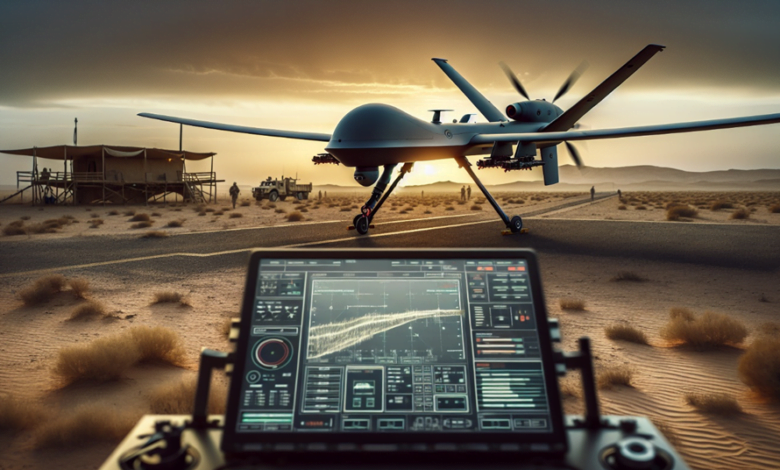On June 8, 2022, a significant escalation in the Iran-Israel conflict was marked by Iran’s launch of a UAV drone attack targeting the Mercer Street, an Israeli-managed oil tanker, off the coast of Oman [1]. Managed by Zodiac Maritime, a British company owned by Israeli billionaire Eyal Ofer, the attack on the vessel resulted in two casualties and has drawn international condemnation, with the United States, Israel, and the United Kingdom blaming Iran for the aggressive act [1]. Although Iran has not officially claimed responsibility, the operation gained praise from Iranian state media, underscoring the intense and ongoing animosities between Iran and Israel [1].
This UAV drone attack is not an isolated incident but part of a series of Iran attacks that have added to the concerns over the safety of commercial shipping in the Arabian Sea region [1]. The international community, including the United Nations Security Council and the European Union, has responded with calls for a thorough investigation and condemnation of the aggression, indicating the attack’s broader implications for regional security and the potential for further escalation [1]. As tensions continue to rise, the incident reflects the growing complexities and challenges in addressing Iran’s use of UAV drones in conflict, setting the stage for an in-depth exploration of its strategic execution, impact, and future implications for regional stability [1].
Background of the Iran-Israel Conflict
The historical backdrop of the Iran-Israel conflict is complex and spans several decades, marked by shifts in diplomatic relations and escalating military tensions:
1. Historical Relations and Shifts:
- 1947-1953: Initially, Iran was among the 13 countries that voted against the United Nations Partition Plan for Palestine [7].
- 1953-1979: During the Pahlavi dynasty, Iran recognized Israel as a sovereign state, becoming the second Muslim-majority country to do so after Turkey [7].
2. Factors Exacerbating Tensions:
- Support for Militant Groups: Iran’s backing of groups like Hezbollah and Hamas has been a significant point of contention [8].
- Nuclear Ambitions: The pursuit of nuclear technology by Iran has heightened fears in Israel, given past threats directed towards Israel’s existence [8].
3. Recent Conflicts and Proxy Wars:
- Cyber Warfare and Sabotage: Both nations have engaged in cyber-attacks and sabotage, reflecting the ongoing proxy conflict that affects regional geopolitics [8].
- Direct and Indirect Military Engagements: The conflict has seen various forms, including support for opposing factions in regional conflicts such as those in Syria and Yemen [8].
This historical and ongoing strife between Iran and Israel sets the stage for understanding the recent UAV drone attacks and their implications within this protracted geopolitical conflict.
The Strategic Execution of Iran’s Attack
Iran’s strategic execution of the UAV drone attack on Israel was meticulously planned and executed with a significant arsenal. Here are the key elements of the attack:
- Diverse Arsenal and Launch Points: Iran utilized a mix of drones, ballistic missiles, and cruise missiles launched from multiple locations including Iran, Iraq, Syria, and Yemen [2][6]. This diverse arsenal included the Emad long-range ballistic missile and the Paveh cruise missile, highlighting Iran’s capability to coordinate complex operations across different territories [3].
- Interception and Defense: Despite the vast number of projectiles launched, Israel’s advanced multilayered air defense systems, such as the Arrow system, David’s Sling, and Iron Dome, successfully intercepted 99% of these threats [10]. The effectiveness of these systems was crucial in preventing significant casualties and damage, with only minor damage reported to an airbase and a minor injury to a civilian [5][6].
- Strategic Objectives: The scale and intensity of the attack suggest that it was not only a demonstration of military prowess but also aimed at strengthening Iran’s deterrence capabilities. This move came in retaliation for a suspected Israeli strike that killed an Iranian military commander, signaling a direct response to escalating tensions between the two nations [3][18]. Additionally, the attack briefly influenced global markets, causing a temporary 15% spike in oil prices, which underscores the broader economic implications of such military actions [19].
This operation marks a significant escalation in the use of UAVs and missile technology in regional conflicts, reflecting Iran’s growing reliance on such tactics in its military strategy.
Impact of the Attack on Israel
The recent UAV drone attack by Iran on Israel has had significant implications, both in terms of physical damage and geopolitical tensions:
- Physical Impact: The attack inflicted minor physical damage at the Nevatim Air Base and resulted in the injury of a 10-year-old girl [10]. This incident highlights the potential for civilian harm in such military confrontations.
- Escalation of Regional Tensions:
- International Concerns: The severity of the attack brought the region “to the edge of the abyss,” as stated by German Foreign Minister Annalena Baerbock, indicating the potential for a broader conflict that could engulf the region [5].
- Responses and Perceptions:
- Israel’s Official Stance: In response to the attack, Israel’s Defense Minister, Yoav Gallant, labeled Iran as “a country of terror,” reflecting the heightened official Israeli stance against Iran following the incident [5].
- Threat to Security: The attack poses a serious threat to regional security and raises concerns about a possible devastating escalation that could impact the entire region [2].
This situation underscores the fragile security dynamics in the Middle East and the potential for further deterioration in regional stability.
International Response and Diplomatic Efforts
The international response to Iran’s UAV drone attack on Israel has been swift and multifaceted, reflecting the global concern over the escalating tensions in the region:
1. Global Condemnations and Calls for Restraint:
2. Diplomatic Efforts and Security Meetings:
3. Impact on International Relations and Travel:
- The incident has strained the already tense relations between Israel and the United States, with implications for international diplomatic alignments [12].
- Several countries have issued travel warnings, highlighting the potential dangers for international citizens in the region [2].
These responses illustrate the delicate balance international actors are trying to maintain, advocating for restraint while preparing for potential escalations.
Future Implications for Regional Stability
The escalating use of UAV drones by Iran poses several future implications for regional stability in the Middle East:
1. Increased Geopolitical Tensions:
- The Iran-Israel conflict intensifies concerns about the overall stability of the Middle East [2].
- The recent attacks have heightened tensions between Iran and the US, with potential repercussions that could lead to a broader conflict [2].
- There is an increased risk of military responses from regional powers such as Saudi Arabia, which could further escalate tensions [11].
2. Vulnerability of Critical Infrastructure:
- The UAV attacks have underscored the susceptibility of critical infrastructures, such as commercial shipping and oil tankers, to drone strikes. This vulnerability has significant implications for global security and the safety of maritime routes [11].
- Recent incidents, like the drone attack on the Japanese-owned MV Pacific Zircon, highlight ongoing threats to commercial shipping, raising alarms over maritime security [20].
3. Wider Conflict Potential:
- The scale and success of Iranian UAV operations could influence whether tensions in the region continue to escalate [18].
- Israel’s response to these threats will be critical in shaping the future course of regional dynamics [18].
These elements illustrate the complex and interconnected threats facing the Middle East, where the increasing use of advanced military technologies like UAVs by Iran and its proxies not only challenges regional security but also has far-reaching implications for international stability [19].
Conclusion
Through this exploration of Iran’s recent UAV drone attack on Israel, we’ve seen a vivid illustration of the ongoing complexities and escalations in regional conflict dynamics, particularly in the context of the long-standing Iran-Israel antagonism. The strategic utilization of UAV technology by Iran not only signifies a concerning shift towards more technologically advanced methods of warfare but also highlights the vulnerabilities of critical infrastructure and the broader implications for regional and even global security. The incident serves as a stark reminder of the fragility of peace in the Middle East and underscores the critical need for international cooperation in addressing these emerging challenges.
Looking forward, the incident catalyzes a critical juncture for diplomatic efforts and international relations, suggesting a pressing need for collective action to prevent further escalation. The global response and the subsequent diplomatic mobilizations underscore the severity of the situation and the potential for broader conflict that could exceed regional boundaries. As the international community grapples with these developments, the importance of dialogue, strategic restraint, and a concerted effort to enhance security and stability in the region becomes increasingly clear. This situation offers a crucial moment for reflecting on the intricate web of political and military strategies at play and the pivotal role of international diplomacy in navigating the turbulent waters of Middle Eastern geopolitics.
References
[1] – https://www.wsj.com/livecoverage/israel-iran-strikes-live-coverage [2] – https://www.aljazeera.com/news/2024/4/14/serious-escalation-world-reacts-to-irans-drone-missile-raids-on-israel [3] – https://www.jpost.com/middle-east/iran-news/the-iran-drone-war-is-now-here-796850 [4] – https://www.aljazeera.com/news/2024/4/13/israeli-army-says-iran-has-launched-drones-at-israel [5] – https://www.pbs.org/newshour/world/live-updates-israel-says-it-intercepted-99-percent-of-irans-drones-and-missiles [6] – https://apnews.com/article/israel-iran-hamas-latest-04-14-2024-42c5166c1df7d871a2302ade55cf7179 [7] – https://en.wikipedia.org/wiki/Iran%E2%80%93Israel_relations [8] – https://www.livenowfox.com/news/why-iran-wants-to-attack-israel-the-history-of-the-conflict-explained [9] – https://www.wilsoncenter.org/event/iran-and-israel-couple-odds [10] – https://www.politico.eu/article/israel-iran-attack-missile-drone-strike-defense-cooperation/ [11] – https://www.reuters.com/world/middle-east/reaction-irans-drone-missile-attack-israel-2024-04-13/ [12] – https://www.theguardian.com/commentisfree/2024/apr/14/iran-drone-attack-israel-crisis-benjamin-netanyahu-tehran [13] – https://www.cnn.com/2024/04/14/middleeast/iran-israel-attack-drones-analysis-intl/index.html [14] – https://www.youtube.com/watch?v=D1A0InH4L7Y [15] – https://www.washingtonpost.com/world/2024/04/14/israel-iran-attack-war-drones-missiles-news/ [16] – https://www.euronews.com/2024/04/14/how-world-leaders-responded-to-irans-drone-attack-on-israel [17] – https://www.pbs.org/newshour/politics/biden-seeks-diplomatic-global-response-as-israel-hails-success-in-blocking-irans-attack [18] – https://www.atlanticcouncil.org/blogs/new-atlanticist/experts-react-iran-just-unleashed-a-major-attack-on-israel-whats-next/ [19] – https://www.jpost.com/middle-east/how-irans-drones-became-a-threat-to-the-mideast-and-world-analysis-796846 [20] – https://www.reuters.com/world/middle-east/iran-launches-drone-attack-israel-expected-unfold-over-hours-2024-04-13/




